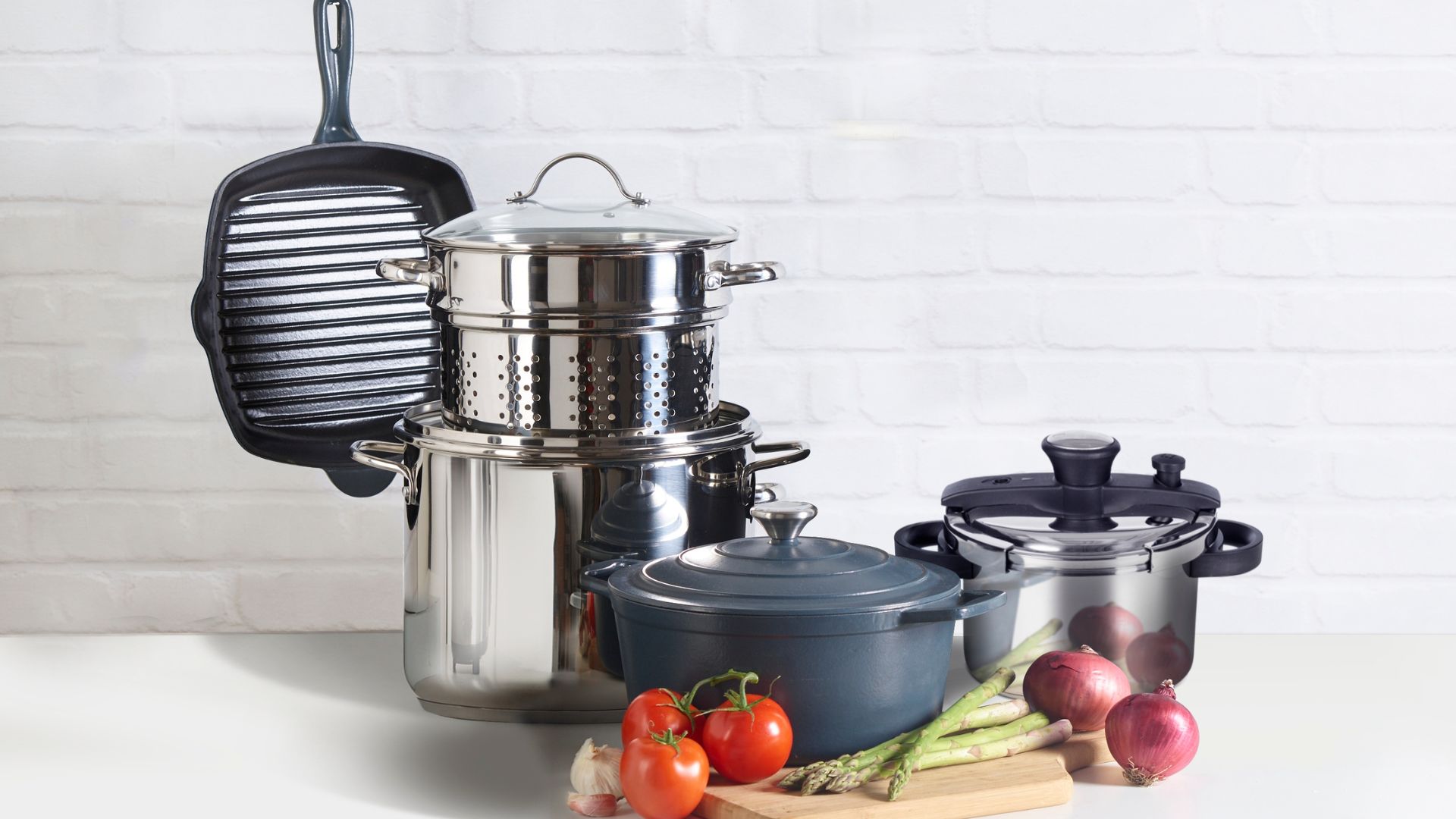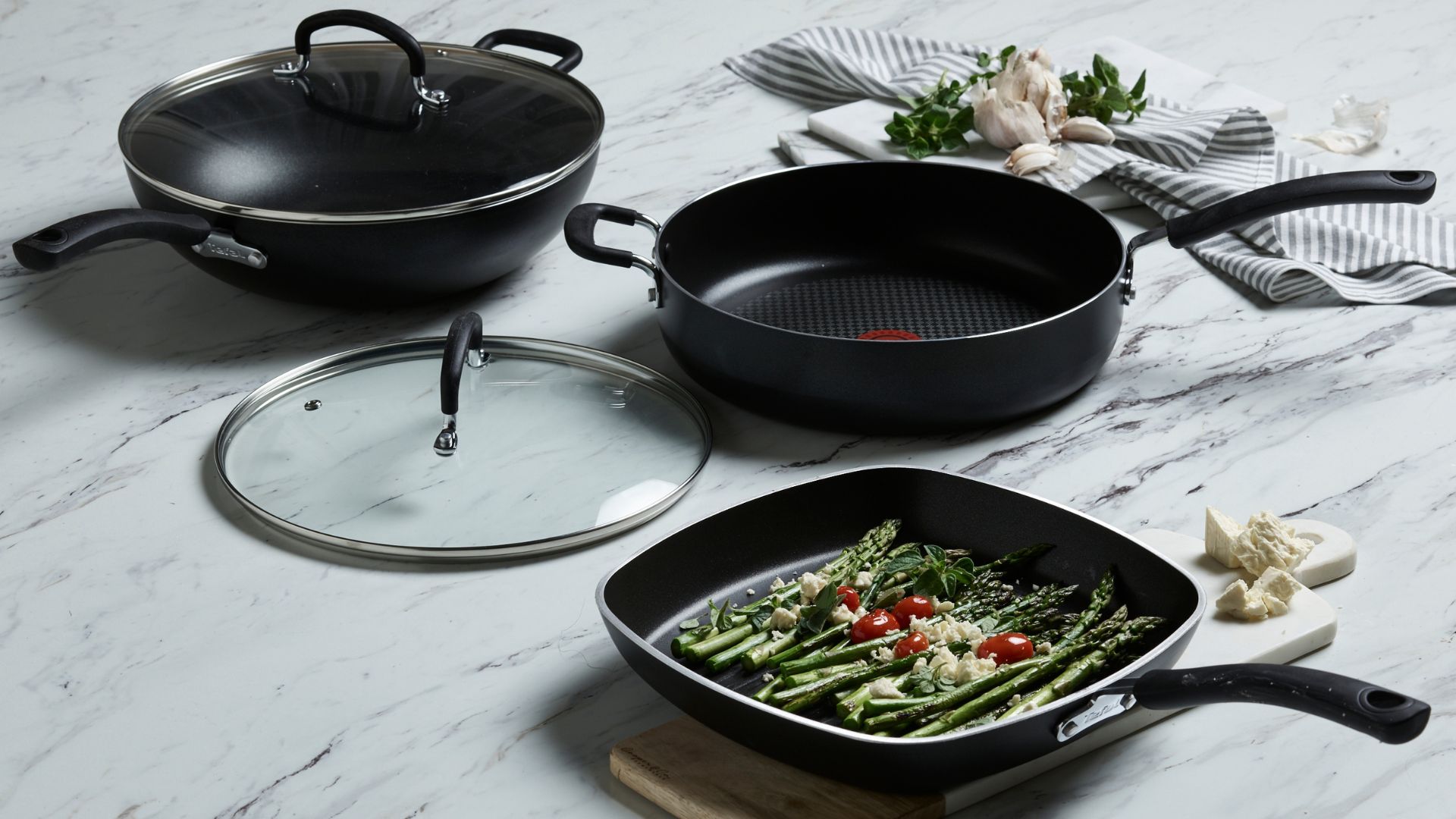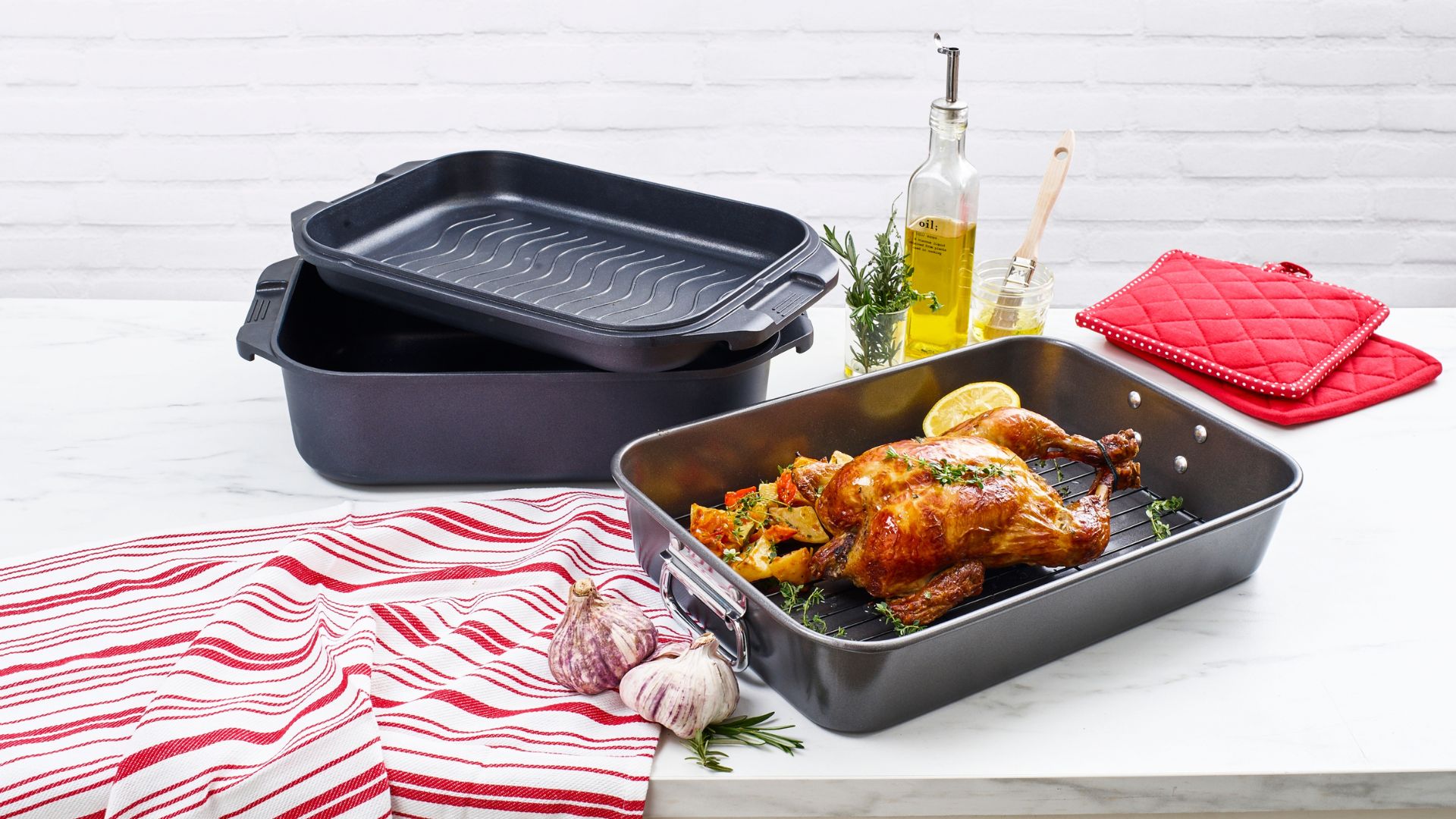 | ||
| Your browser is not supported. | ||
|
Please browse our site using any of the following options:
| ||
How To Choose The Right Cookware: Ultimate Guide

Creating your own delicious meals at home can be very rewarding and it's also a wonderful way to show others you care - who doesn't appreciate a home-cooked meal? But with the advances of modern technology and the evolving world of modern cooking, the amount of cookware and utensils out there can be enough to confuse even the most experienced chefs! At Spotlight we sell an extensive range of kitchenware, from large, versatile appliances to small tools only suited for one technique. To help you make sense of it all, this buying guide will go through everything you need to consider when buying cookware, from size constraints and material to stove type and cooking technique.
Read on, and ensure you can make the right cookware purchase every time!
Quick Links
- Why The Right Cookware Is Important
- A Quick Guide to Common Cookware Types
- Best Cookware Material For Different Kinds Of Cooking
- Best Cookware Size For Cooking With
- Best Cookware For Different Stove Types
- Best Cookware For Different Cooking Techniques
Why The Right Cookware Is Important
Choosing the right tools for the job is important in any situation, and it's no different when it comes to cooking. Cooking with kitchenware that is the wrong size or material can lead to your food burning, sticking or even at times taking on the flavour of the vessel in which it is being cooked. Cooking with the right kitchenware, on the other hand, can speed up the cooking process, add delicious flavour to your meal and ensure a quick and easy cleanup once you're done. So take the time, learn what is best and enjoy making some amazing food with the right cookware!
A Quick Guide to Common Cookware Types
There's a lot of cookware out there - from everyday essentials to niche appliances used for one thing only. Here is a quick rundown on the most popular kinds of cookware, including settling the saute pan vs fry pan question, as well as answering popular queries like 'what is a skillet'?
- A fry pan is a shallow pan with flared sides and a wide base. It will be shallow and thin, perfect for heating up frying foods quickly! They usually have a single long stick handle.
- A skillet is a pan with sloped sides, a flat base and a handle.They often come with a fitted lid, and are deeper than fry pans.
- A sauce pan is a small, deep pot used for cooking liquids on the stovetop. They have steep, flat sides, a flat bottom and a long handle on the side,
- A saute pan is a pan with vertical sides, a fitted lid and a wide bottom. They have a long stick handle on the side and are, size-wise, in the middle between a frypan and a saucepan.
- A chef's pan is a large, flat pan with curved sides and a fitted lid. They often have either two handles on either side or a stick and grip handle combination.
- A stock pot is a large, very deep pot with flat sides and a fitted lid. It will have grip handles on either side for movement.
- A wok is a larger round bottom, high walled pan which is commonly used for cooking Asian cuisine. It usually features a long handle and can be made from carbon steel, stainless steel or even cast iron.
Saute Pan vs Fry Pan
This is a common debate, both pans are kitchen essentials but depending on your cooking style you may prefer one over the other. Saute pans have higher sides which is better for stir fries and even cooking curry and stew. Whereas a frypan gives you easy access and a larger cooking surface for omelettes and meats.

What is the Best Cookware Material For Different Kinds Of Cooking?
Cookware for your kitchen can come in a variety of materials, with each having its own strengths and weaknesses depending on how you plan on using them.
- Aluminium - one of the lightest metals you'll find in cookware, aluminium heats up very quickly compared to cookware made of other materials. It is also very affordable, making aluminium cookware a great choice for anyone looking for affordable but effective pots and pans. Make sure you are choosing aluminium that has been anodized, as this makes it more durable and ensures acidic foods won't cause the metal to leech into your cooking.
Because it heats up quickly and evenly, aluminium cookware is great for quickly and evenly searing meats or tossing together a tasty stir-fry. Anodized aluminium is perfect for making your morning eggs and bacon too!
- Ceramic - you can find 100% ceramic cookware that has been baked and glazed out of materials like quartz sand and clay, or metal cookware that has a ceramic coating. Ceramic cookware is non-stick and easy to clean, plus can come in a variety of beautiful colours to match your other kitchenware. Be aware that ceramic cookware isn't as long-lasting as other metals though.
Ceramic baking dishes are great using in the oven to make pasta bakes, puddings, or even a baked risotto.
- Cast iron - when you hear about 'seasoning' your cookware, cast iron is the material usually referred to. Cast iron is perfect for frying and baking, and if cared for can last for generations! Heavy cast iron skillets and dutch ovens can be used in the oven for baking, as well as for cooking on the stovetop.
Use them in the oven for baking pies and tarts, and on the stove for cooking anything that needs a consistent level of heat, as it retains warmth for a while when used.
- Stainless steel - cookware made from this lustrous metal retains heat nicely and will cook your food evenly, plus it's easy to clean. You can even pop it in the dishwasher! Stainless steel is durable and lighter than cast iron, but heavier than aluminium cookware. Use it for making delicious pasta sauces, deglazing and making gravy or even pan-searing a steak.
- Anodised Steel and Aluminium - anodising is an electrochemical process that coats and seals the metal to create an extremely durable and scratch resistant surface.
The best cookware material for you will depend on what kind of stovetop you have and the kind of food you are cooking. Some materials cannot handle acidic foods and stay intact, and acidic food can also leech through a seasoned pan and destroy your non-stick coating - so be careful with what you cook with!
Non-Stick vs Stainless Steel Cookware
If you have seen bits of the non-stick vs stainless steel debate, know this - stainless steel becomes low-stick at a high temperature, but will never be as non-stick as a coated pan. Stainless steel has other benefits including being durable and dishwasher safe though, so don't discount it! Non-stick cookware is convenient and easy to reduce use of oil in cooking but does require gentle handling and washing.
Best Cookware Size For Cooking With
When it comes to cooking, one size definitely doesn't fit all! But you also don't want to have three different sizes of every piece of cookware you own, so how do you choose what you really need? To choose the right stockpot, skillet and frying pan size, check out the size guides below:
- Small cookware - a small pan is handy for making small meals, and is perfect if you live alone. A fry pan or skillet around 20cm can make a single fried egg, crepe, or omelette, or reheat a single serving of food. Small cookware is also easy to clean and store away after use.
- Medium cookware - a medium 25 cm frypan is perfect for browning off some meat for dinner or cooking eggs and bacon for brekkie. A medium skillet is also handy for making gravy and reducing sauces. Use a medium saucepan for making rice, porridge and soup for a small household.
- Large cookware - while they can be large, heavy and a bit of a pain to clean, large cookware can be useful even for small families. A large stockpot can be used to make soups and large amounts of pasta, while a 30cm frypan can handle sauteing, frying and shallow-frying easily.
Overall, your pot and frying pan size will change depending on the size of your household, the kinds of food you like to cook and how much storage space you have. In general we would recommend having a large and small frypan, a medium saucepan, a large stockpot and then a medium-sized steamer as well. This gives you plenty of options for making small and large amounts of most kinds of food.
Should I Invest in a Cookware Set?
A cookware set is an amazing investment, allowing you to save money instead of buying individual prices. For a family or individual moving out for the first time, invest in a quality 6 piece cookset to have all the essentials available. Cooksets also come in different sizes, stock up a 3 piece saucepan set or 2 piece frypan set depending on your needs. When looking for the best cookware set, always weigh up the price, size and material, ensuring it suits your hob and cooking requirements. Every home cook needs a reliable cookset to create delicious healthy meals at home.

Guide to the Best Cookware For Different Stove Types
Did you know that not all kinds of pans can be used on an induction/electric stove? Depending on your stove or cooking surface type, certain cookware may be a better choice over others.
- Gas stove - because it produces a high-temperature flame to cook on, you'll need cookware that can stand being instantly exposed to high temperature, as well as withstanding any fluctuations. You want cookware for a gas stove to retain that heat, as well as not discolour or warp after use. The best cookware for a gas stove is cast iron, with stainless steel coming second only because food sticks to it easier and it's not quite as durable.
- Induction stove - only certain kinds of cookware will work on an induction stove, so what cookware you choose for an induction stove is important if that's the only stovetop in your home. Because it creates heat using a magnetic field, you'll need cookware that has iron in it or another layer with magnetic properties for the field to properly interact with the cookware. Cast iron and most stainless steel will work, while glass, aluminium and copper cookware will not. You can test your cookware by holding a magnet to the bottom of your cookware - if it sticks strongly, it's fine to use on an induction stove.
- Oven - if you plan on using any of your pots and pans in the oven, ensure their maximum safe temperature is not exceeded. Cookware with wooden or plastic handles should also not go in the oven. Carbon steel has the highest heat tolerance, and stainless steel is also a good option. Cast iron is effective in the oven, but because it is quite heavy and bulky it can be unsafe to lift out of a high oven, so be careful when using it.
- Electric stove - smooth top electric stoves can be scratched easily by the rough texture of cast iron cookware, so look for stainless steel and coated aluminium products that are smooth on the bottom. A coil-style electric stove is more durable, so look for anodized aluminium pans, stainless steel, carbon steel and cast iron for these stoves.
In the case of everything but induction cooktops, you can use any type of cookware in a pinch. Just be aware your cookware may warp, blacken or unevenly spread heat if you choose to do so.
Best Cookware For Different Cooking Techniques
Depending on how you cook your food, certain types of cookware will be more appropriate than others.
- Grilling indoors - a grill pan or plate is the perfect way to get that tasty char and attractive lines on your proteins. Cast iron is the best option for its ability to heat up and retain heat. Stainless steel is also a good choice, but it won't retain heat as well as cast iron does.
- Sauteing and Stir Frying - 'what is sauteing?' you may ask? To saute is to fry something quickly in a small amount of hot oil or fat. You can use a fry pan for sauteing, but did you know saute pans exist? They are deeper than a frypan, with straight sides and an included lid that locks in moisture. If you want to make a juicy casserole or a fragrant curry, a saute pan will keep all your sauce where it needs to be and prevent your dish from drying out.
- Shallow frying - a fry pan or skillet is your best choice for shallow frying anything like a crumbed schnitzel or tasty chicken strips. Make sure there is at least 5 cm of length in the sides of your chosen pan so you can fill it with enough oil to cook your food in.
- Deep frying - if you want to deep fry on the stove, use a pot with high sides, like a dutch oven. The high sides enable you to easily coat your food in oil without having to use a whole bottle, and it'll keep the splattering to a minimum. Pots with a lid are also a good choice for safety reasons - if a fire breaks out, you can smother it by placing the lid on the pot.
- Roasting - a roasting pan and rack is the obvious choice for roasting in the oven. Look for materials like cast iron, carbon steel or stainless steel. If you don't have a roasting pan or it seems too big for what you want to cook, you can use a cast iron skillet, baking tray, casserole dish or even a cake pan to get the job done.
- Steaming - stainless steel and aluminium steamers are the most common types you'll see around, although bamboo steamers are a popular choice for steaming things like dumplings. You can also use a colander over a saucepan with a fitted lid if you don't want to buy a separate steamer.
Keep in mind how much of a certain technique you use before buying cookware. If you rarely steam your veggies you can make do with the saucepan/colander method instead of buying a steamer, and if you love to bake desserts but rarely roast meat in the oven, one of your cake pans will do the job and save you money instead of buying a roaster.
Find The Right Cookware At Spotlight
Now that you know the right cookware to buy, it's time to start shopping! You can shop the entire Spotlight cookware range online or at your nearest Spotlight store. Shop cookware from leading brands including Tefal cookware, Circulon cookware, Scanpan Cookware and more. For more kitchen buying assistance, check out our buying guides for kitchen appliances, dessert bakeware and kitchen knives to fully equip your kitchen. Find everything you need to become a great cook at home with the range at Spotlight.




